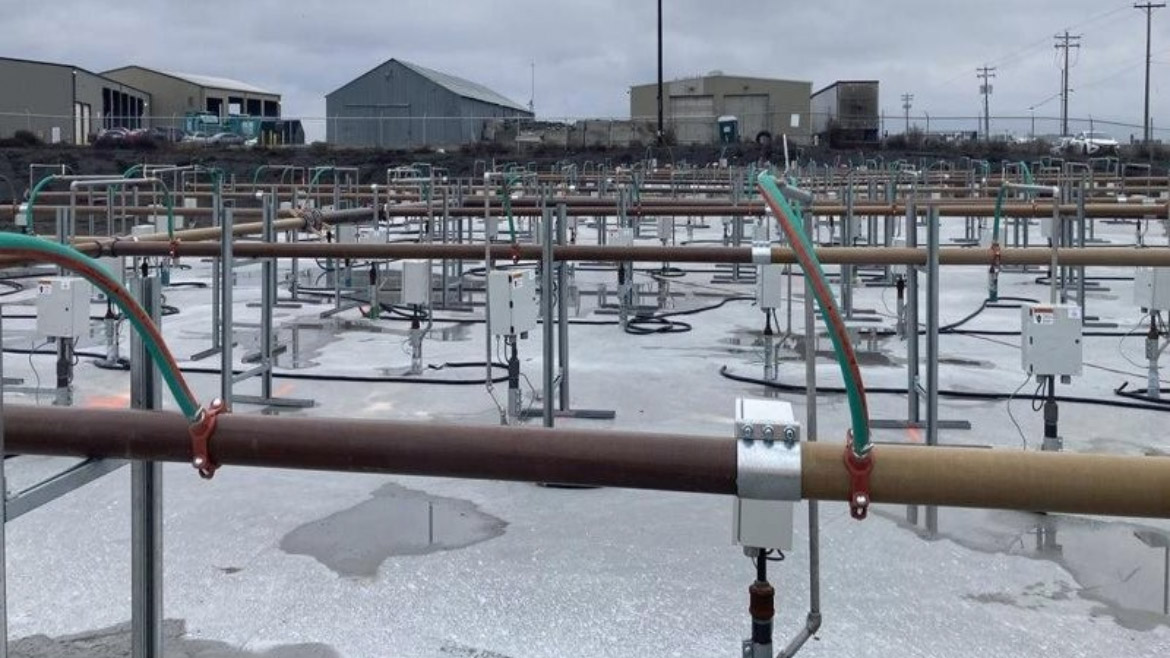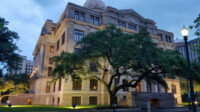Cleanup Crews Race to Contain Groundwater Contamination at Pasco Landfill
Department of Ecology issues amended enforcement order requiring a ramp up groundwater monitoring

The thermal treatment system for soil contamination in Zone A of the Pasco Landfill. (Courtesy of the State of Washington Department of Ecology)
Residents north of the intersection of Highway 12 and E. Lewis St.-Kahlotus Rd. in Pasco, Washington, may notice an uptick in cleanup activity in their neighborhood as crews scramble to address a recent surge in groundwater contamination emanating from the Pasco Landfill Superfund site.
The contamination spike occurred in the aftermath of a major industrial waste removal operation overseen by the Washington State Department of Ecology in 2022. During the effort, more than 35,000 drums of industrial waste were extracted from Zone A of the landfill. However, chemicals released from the soil surrounding the former drum burial sites were not fully captured by the thermal treatment system, leading to the increased contamination.
While local residents and businesses do not rely on groundwater as a drinking water source, and there is currently no risk to the public, the situation has prompted swift action from the Department of Ecology and the parties held responsible for the cleanup.
"We are working closely with the parties responsible for cleanup to increase chemical recovery from soil and groundwater and ensure public safety," a Department of Ecology spokesperson stated.
The Department of Ecology has issued an amended enforcement order requiring the responsible parties to ramp up groundwater monitoring, treat the recent contamination to prevent its spread, and assess potential vapor intrusion risks in nearby buildings. The order, which went into effect on November 20, includes a detailed cleanup plan, scope of work, and timeline for completion of the new activities.
The public has been invited to provide input on the amended order through January 20, 2025. Comments can be submitted online, via email to Jeremy.Schmidt@ecy.wa.gov, or by mail to 4601 N. Monroe St., Spokane, WA 99205.
Despite the setback, officials remain optimistic about the progress made at the site and the collaborative efforts underway to rectify the situation.
"While we are disappointed about the recent release of groundwater contamination off the Pasco Landfill property, we are encouraged by the quick action, collaboration, and technical expertise between Ecology and the responsible parties," said Nick Acklam, Eastern Region manager of the Toxics Cleanup Program. "This work will lead to containing and treating the contamination, which will prevent further movement and limit potential impacts to air quality."
Pasco Landfill Cleanup: A Decades-Long Effort
The Pasco Landfill, a sprawling 200-acre site northeast of the city, has a long and troubled history. It opened in 1958 as a trench burning waste disposal site, a primitive method where waste was set ablaze in open trenches. This dangerous practice continued until 1971. The site then transitioned to a sanitary landfill but took a turn for the worse from 1972 to 1975, when it began accepting industrial waste.
The landfill's activities caught the attention of the Environmental Protection Agency, which added the site to the National Priorities List in 1990, designating it as one of the most hazardous waste sites in the country. The Washington State Department of Ecology took over oversight in 1991, and the landfill was finally closed in 2001.
But closing the landfill was only the beginning. The real work – the painstaking and dangerous process of cleanup – was just getting underway. In the early 2000s, work began on several industrial waste zones and municipal solid waste disposal areas within the site. The most significant recent progress has been in Zone A, where removal of hazardous waste drums began in fall 2020. By early June 2022, all drums had been removed, totaling approximately 23,500 tons of waste safely hauled away to out-of-state facilities equipped to handle hazardous materials.
The cleanup goes beyond just removing drums. Thermal treatment is being used to decontaminate the soil itself, ensuring that the remaining pollution is neutralized. Once this treatment is complete in a given area, a final cover system will be put in place, essentially capping the site and preventing any further leakage of hazardous substances.
But even as active cleanup draws to a close, the Pasco Landfill will remain a restricted site. Fences and signs will remain, and there will be ongoing limitations on how the property can be used. Importantly, groundwater monitoring will continue indefinitely. The groundwater protection area in east Pasco will stay in place until the Department of Ecology is confident that the groundwater is safe.
Over the past two decades, these cleanup efforts have made a significant difference. Groundwater contamination both on the landfill property and in surrounding areas has decreased. The work at the Pasco Landfill serves as a testament to the fact that even the most polluted sites can be made safer, but it also highlights the ongoing challenges and responsibilities that come with dealing with our nation's hazardous waste legacy.
Key Milestones
- 1958: The Pasco Landfill opens as a trench burning waste disposal site.
- 1971: The site transitions to a sanitary landfill.
- 1972-1975: The landfill accepts industrial waste.
- 1990: The EPA adds the site to the National Priorities List.
- 1991: The Department of Ecology takes over oversight.
- 2001: The landfill is closed.
- Early 2000s: Cleanup activities begin.
- Fall 2020: Removal of hazardous waste drums begins in Zone A.
- Early June 2022: All drums are removed from Zone A.
Looking Ahead
- Thermal treatment of soil will continue until all contaminated areas have been addressed.
- Final cover systems will be placed on treated zones.
- Groundwater monitoring will continue indefinitely.
- The groundwater protection area in east Pasco will remain in place until deemed no longer necessary by the Department of Ecology.



